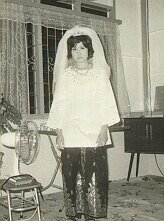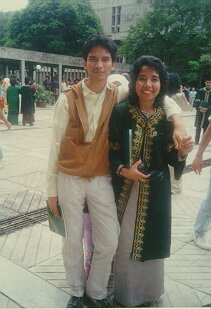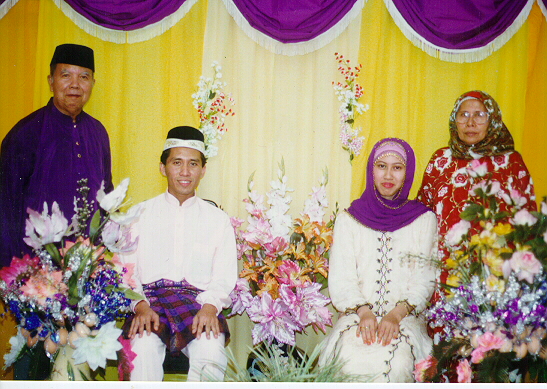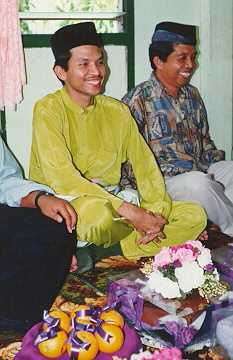

|
|
|
|
|
|
|
|
|
|
|
|
|
|

 |
Abdul Shukor Abdul Manan - Bang Ol |  |
Asimah Abdul Manan - Kak Nomek |
 |
Nor Ashikin Abd. Manan @ Atin - Kak Cik | Suzana Abd. Manan @ Ana - Kak Teh | |
| Norlaila Abd. Manan @ Ella | Rosdan Abd. Manan @ Adan |
| My brother Rosdan was married on 1st June 1997. The ‘kenduri’
or reception was held at the house of the bride in Johor Bahru. Specific
wedding customs vary from area to area. Traditional Johor Malay customs
normally went through a few stages. When a man want to marry a woman, he
will tell his parent (marriage is a very much a family affair!). His parent
then will arrange for a relative to checkout the girl's family. In our
case, my uncle who is living in Johor Bahru act as our 'wakil'
(representative). This tradition is called 'merisik'
(investigation). The wakil than will pay the girl's parents a visit and
tell them (indirectly) about their intention.
The girl's parent then will tell them (also indirectly) the status of their daughter (whether there is anybody else or not, whether the girl is ready yet to get married etc.). Normally the 'wakil' will leave the girl with a simple gold ring as a sign of `booking’. If the girl (or the parent) did not want to proceed, she can return the ring to the wakil in a week or a month time (depending on the time frame agreed by both parties). After agreement had been reach, the boy's family will set a date for the official engagement troupe to be sent to the girl's house. The boy's parents will follow the troupe bringing the 'hantaran' (gifts) to the girl and half of the agreed sum of `wang belanja’ (expenses money- the money is normally use by the girl's parent to pay for the wedding reception. My three sisters’ hantaran amount were RM3,000.00). This money is an addition to the 'mas kahwin' (dowry) to be paid by the man to his future wife. This is a compulsory gift according to Muslim tradition. The mas kahwin amount is determined by the state religious department (this is to prevent the girl putting the price too high!) In Johor, the amount is RM22.50. Beside in the form of money, it can be in the form of other gifts. |
|
|
My third sister's 'mas kahwin'
is a gold necklace. My brother gave his bride a gold ‘loket’
or pendant. Other gifts are jewellery, cakes, fruits, perfume, clothing
item, sireh junjung (betel leaves)
etc. (see photo). All the gifts will be presented
on trays. If the boy bring 7 tray of gifts, the girl will reply with 9
trays. If the boy bring 15 trays, the girl will reply with 17 trays and
so on and so forth (always the odd number, and the reply will normally
more). The date for the wedding ceremony will be set.
The duration of the engagement can be from 3 month to 3 years. |
| The wedding ceremony will be divided into 2 section -
the religious ceremony and the traditional portion. The religious ceremony
will consist of the formal solemnisation perform by the girl's father in
front of the officials from the religious department (normally an ‘Imam’
or ‘Kadhi’) The officials then will
read out the wedding sermon either after or before the solemnisation. The
content of the sermon is basically a reminder on the responsibility of
each as husband and wife and procedure to seek redress on marital problem.
Normally, this will be held a night before the reception or in the morning
of the reception itself.
If the solemnisation happen a night before the reception, the couple will go through the ‘berinai’ ceremony after that. Inai is red henna. It will be applied on the hands of both couple as a sign of blessing. The family member from both sides will take turn to perform this tradition while the couple was seated on a special dais ‘pelamin’. Beside henna, sometimes they have popcorns, rice and flour mixture applied on the palm and forehead or showered on both couple. These are Malay traditions and nothing to do with religious requirement. Other activities on that night will be the recital of the holy verses from the Quran by the brides and her maiden's friends, the reading of poetry about the prophet (berzanji), doa or prayers for the couple and of course food! In some area, the berinai ceremony is strictly women's affair while the men folk prepare for the feast. In many rural kampung, family and friends from far away will spend the night at the host house. An elderly woman attendant or ‘Mak Andam’ trims the bride's hair and applied henna to her hands and feet after the Koran reading session. The next day (the reception) the ceremony will start with the feast from lunchtime (around 11.00am) till about 3.00pm. The ‘Bersanding’ ceremony begins at 3.00. ‘Bersanding’ is sitting-in-state, theoretically the first time the young couple meets. The bride is seated on chairs on a platform or on a richly decorated bed. The noise of the kompang (drums) announcing the bridegrooms procession is heard outside but she may still have to wait a little while. Although the groom is carried, paddled or driven from his house to hers in splendour, he may not be allowed in! Member’s of the bride's household vociferously refuse entry until some gift presented to all the people who are blocking the way, normally young girls. The biggest ‘gift’ will go to the Mak Andam who is sitting beside the bride and holding a fan to cover the bride's face. |
 |
After both of them were seated there will be other ceremonies perform
on them like the blessing of the couple using scented water. If the berinai
ceremony was not done the previous night, henna will now be applied on
their hand and forehead. Sometimes sandal wood paste and rice flour paste
was used. The ‘bersanding’ would publicly
ratify the union. The guest than will be entertain with the performance
of ‘silat’ or the Malay traditional
martial art, ‘nashid’ or religious
song etc.
The happy couple will be seated on a 'pelamin' (special dais; see photo) for everybody to see. It will be followed by photography session. The ceremony wills ends with the special wedding feast for the couples and their in laws. These are all customs and tradition. Not compulsory. Notice the 'henna' effect on my sister in law's finger? |
 |
Most of the ceremonies are still being practice now. All my three sister
when through all or part of the ceremony.
My brother's wedding did not follow the whole tradition. He merges the
engagement ceremony and the solemnisation. This is because the bride's
family plans to hold the reception in December, together with her sister's
wedding. My parents persuade the girls parents to allow them to went through
the solemnisation earlier because the girl is now studying in Kuala Lumpur
and it will be convenient for her to stay with my brother. (There is no
such thing as ‘staying together without married’ in our society). A week
after the wedding, my parents held a small reception to welcome a new member
to our family. Now, I'm the only bachelor in my family. The photo of a happy brother and an uncle (Pok Long Manap), during the solemnisation. We were laughing at a joke crack by the Imam in his wedding sermon. I hope I'm not confusing you with all the Malay terms. Actually some of the terms can never be accurately translated into English. |
 muluk@ppp.nasionet.net
muluk@ppp.nasionet.net